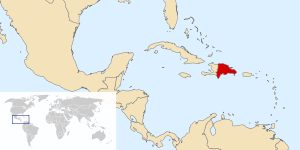Spanish occupation of the Dominican Republic
| Captaincy General of Santo Domingo Spanish occupation of the Dominican Republic | |||||||||
|---|---|---|---|---|---|---|---|---|---|
| 1861–1865 | |||||||||
.svg.png) | |||||||||
 | |||||||||
| Status | Spanish colony | ||||||||
| Capital | Santo Domingo | ||||||||
| Common languages | Spanish | ||||||||
| Government | Monarchy | ||||||||
| Queen | |||||||||
• 1861–1865 | Isabella II of Spain | ||||||||
| Captain General | |||||||||
• 1861–1862 | Pedro Santana | ||||||||
• 1864–1865 | José de la Gándara | ||||||||
| History | |||||||||
• Establishment | 1861 | ||||||||
• Restoration of Dominican sovereignty | 1865 | ||||||||
| Area | |||||||||
| 48,442 km2 (18,704 sq mi) | |||||||||
| Currency | Santo Domingo peso, Spanish peso | ||||||||
| |||||||||
In 1861, Dominican general Pedro Santana asked queen Isabella II of Spain to retake control of the Dominican Republic, after a period of only 17 years of independence. Spain, which had not come to terms with the loss of its American colonies 40 years earlier or so, accepted his proposal and made the country a colony again.
The end of the U.S. Civil War in 1865 and the re-assertion of the Monroe Doctrine by the United States (no longer involved in internal conflict and possessing enormously expanded and modernized military forces as a result of the war) prompted the evacuation of Spanish forces back to Cuba in that year.
Resistance
.jpg)
By 1862, the Spaniards were contending with a limited insurgency and losing hundreds of soldiers to guerrillas and the devastation of yellow fever.[1] A major uprising began in earnest in August 1863, motivated by the Spanish government's attempts to impose strict Catholicism and the Hispanization of most government and military positions.[1] On September 14, 1863, a provisional government led by General José Antonio Salcedo formed in Santiago, dedicated to the expulsion of the Spanish presence. Adding to the enthusiasm for the rebellion were fears that Spain planned to reintroduce slavery in Santo Domingo, given its continued existence in the Cuban and Puerto Rican colonies. This fear transformed the uprising into an increasingly racial conflict—a conflict the Europeans could not win, given the overwhelming mulatto majority. Rebels burned and looted property and raped and murdered whites.[1] By the end of the conflict, Spain had spent over 33 million pesos[1] and had suffered 10,888 killed or wounded in action.[2] The 12,000 pro-Spanish southern forces recruited by Santana had also suffered about 10,000 casualties.[2] The fatal losses among the Cibao-based nationalist armies were estimated at 4,000.[2]
Governors
1861–1865
- 1861–1862: Pedro Santana
- 1862–1863: Felipe Ribero y Lemoine
- 1863–1864: Carlos de Vargas
- 1864–1865: José de la Gándara